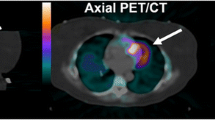Abstract
Objectives
Magnetic resonance imaging (MRI) acquired on equipment capable of simultaneous MRI and positron emission tomography (PET) could potentially provide the gold standard method for motion correction of PET. To assess the latter, in this study we compared fast 2D and 3D MRI of the torso and used deformation parameters from real MRI data to correct simulated PET data for respiratory motion.
Methods
PET sinogram data were simulated using SimSET from a 4D pseudo-PET image series created by segmenting MR images acquired over a respiratory cycle. Motion-corrected PET images were produced using post-reconstruction registration (PRR) and motion-compensated image reconstruction (MCIR).
Results
MRI-based motion correction improved PET image quality at the lung-liver and lung-spleen boundaries and in the heart but little improvement was obtained where MRI contrast was low. The root mean square error in SUV units per voxel compared to a motion-free image was reduced from 0.0271 (no motion correction) to 0.0264 (PRR) and 0.0250 (MCIR).
Conclusions
Motion correction using MRI can improve thoracic PET images but there are limitations due to the quality of fast MRI.







Similar content being viewed by others
References
Nehmeh SA, Erdi YE, Ling CC, Rosenzweig KE, Schoder H, Larson SM, Macapinlac HA, Squire OD, Humm JL (2002) Effect of respiratory gating on quantifying PET images of lung cancer. J Nucl Med 43:876–881
Dawood M, Lang N, Jiang X, Schäfers K (2006) Lung motion correction on respiratory gated 3-D PET/CT images. IEEE Trans Med Imaging 25:476–485
Li T, Thorndyke B, Schreibmann E, Yang Y, Xing L (2006) Model-based image reconstruction for four-dimensional PET. Med Phys 33:1288–1298
Qiao F, Pan T, Clark JW, Mawlawi OR (2006) A motion-incorporated reconstruction method for gated PET studies. Phys Med Biol 51:3769–3783
Lamare F, Ledesma Carbayo MJ, Cresson T, Kontaxakis G, Santos A, Cheze Le Rest C, Reader AJ, Visvikis D (2007) List-mode-based reconstruction for respiratory motion correction in PET using non-rigid body transformations. Phys Med Biol 52:5187–5204
Dikaios N, Fryer TD (2011) Acceleration of motion-compensated PET reconstruction: ordered subsets-gates EM algorithms and a priori reference gate information. Phys Med Biol 56:1695–1715
van Sörnsen de Koste JR, Senan S, Kleynen CE, Slotman BJ, Lagerwaard FJ (2006) Renal mobility during uncoached quiet respiration: an analysis of 4DCT scans. Int J Radiat Oncol Biol Phys 64:799–803
Pichler BJ, Kolb A, Nägele T, Schlemmer H-P (2010) PET/MRI: paving the way for the next generation of clinical multimodality imaging applications. J Nucl Med 51:333–336
Pichler BJ, Judenhofer MS, Wehrl HF (2008) PET/MRI hybrid imaging: devices and initial results. Eur Radiol 18:1077–1086
van Vaals JJ, Brummer ME, Dixon WT, Tuithof HH, Engels H, Nelson RC, Gerety BM, Chezmar JL, den Boer JA (1993) “Keyhole” method for accelerating imaging of contrast agent uptake. J Magn Reson Imaging 3:671–675
Pan T, Lee TY, Rietzel E, Chen GT (2004) 4D-CT imaging of a volume influenced by respiratory motion on multi-slice CT. Med Phys 31:333–340
Zeng R, Fessler JA, Balter JM, Balter PA (2008) Iterative sorting for four-dimensional CT images based on internal anatomy motion. Med Phys 35:917–926
Studholme C, Hill DLG, Hawkes DJ (1999) An overlap invariant entropy measure of 3D medical image alignment. Pattern Recognition 32:71–86
Lewellen TK, Kohlmyer SG, Miyaoka RS, Kaplan MS, Stearns CW, Schubert SF (1996) Investigation of the performance of the General Electric ADVANCE positron emission tomograph in 3D mode. IEEE Trans Nucl Sci 43:2199–2206
Madsen MT (1999) PET attenuation correction using mean attenuation coefficients: a simulation study. IEEE Trans Nucl Sci 46:2172–2176
Hudson H, Larkin R (1994) Accelerated image reconstruction using ordered subsets of projection data. IEEE Trans Med Imaging 13:601–609
Thielemans K, Mustafovic S, Tsoumpas C (2006) STIR: software for tomographic image reconstruction release 2. IEEE Nucl Sci Symp Conf Rec 2174–2176
Acknowledgements
ND was jointly funded by the Bakalas Foundation and the Cambridge European Trust: George and Marie Vergottis Bursary. DI-G, VM and ZAF were partially funded by an NIH grant (NIH/NHLBI R01HL092989). MJG acknowledges financial support from the Department of Health through the National Institute for Health Research Comprehensive Biomedical Research Centre award to Cambridge University Hospitals NHS Foundation Trust in partnership with the University of Cambridge. TDF was funded by the Higher Education Funding Council for England (HEFCE).
Author information
Authors and Affiliations
Corresponding author
Rights and permissions
About this article
Cite this article
Dikaios, N., Izquierdo-Garcia, D., Graves, M.J. et al. MRI-based motion correction of thoracic PET: initial comparison of acquisition protocols and correction strategies suitable for simultaneous PET/MRI systems. Eur Radiol 22, 439–446 (2012). https://doi.org/10.1007/s00330-011-2274-4
Received:
Revised:
Accepted:
Published:
Issue Date:
DOI: https://doi.org/10.1007/s00330-011-2274-4




